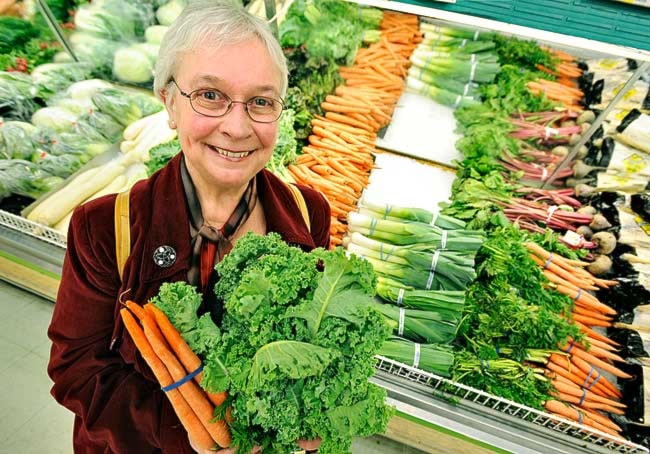Even ordinary things, like the sandwich you packed for lunch or the leftovers in the fridge, have a fascinating and exotic history.
At least Yukon writer Claire Eamer thinks so.
The bizarre back story and strange science behind everyday foods is the subject of her new children’s book, The World in Your Lunch Box.
The book is written for children but it’s filled with enough fascinating facts to keep a person of almost any age interested.
For example, did you know that pepper was once more precious than gold or that potato chips were invented as a prank and that hotdogs got their name thanks to a misspelled cartoon?
While all five of Eamer’s books have been written for a young audience, she’s not just a children’s author. She’s has been writing for decades, mostly on topics related to science. But writing for children is something she loves to do.
“With kids’ books, you find the enthusiasm and express that enthusiasm, and that’s a lot of fun,” she said. “You can also write about really gross stuff, which is cool ... And rather sadly it’s what interests me too.”
The book is divided into seven days of school lunches, and explains the history and science behind each of them.
All the food profiled in the book is relatively pedestrian.
There’s nothing in the book that a typical Canadian kid wouldn’t find in their lunch box, said Eamer.
However, the science and the history behind it are anything but ordinary.
“It’s just the normal stuff but it’s interesting if you really look at it,” she said. “It’s great to be curious about dinosaurs, and everybody is, but to be curious about things right in front of you is good too.
“And it’s good to start thinking about the questions you can ask about the things that are right in front of you, that you take for granted. It’s worth asking some of those questions because the answers will be really, really cool.”
It was Eamer’s husband who provided the inspiration for this book.
“It started because my husband was doing a bunch of research because he had to change his diet and when he does something he gets really thorough about it,” she said.
“He was researching a lot of the science related to food and I was looking at a lot of the books he was looking at and it got really interesting.
“I’m in it for the research actually. You have to write it eventually to justify the research, but the research is a blast.”
The thing that surprised her the most was how many common foods, like potatoes, peppers, corn, chocolate and vanilla, are indigenous to the Americas.
“The sheer scale of agriculture in the Americas and the sophistication of it surprised me,” she said. “We know so little about the pre-Columbian America, and here in the North we know relatively little about South and Central America, where all this stuff was happening.
“The complexity of those civilizations and the amazing agriculture that they practised and the innovations that they came up with has been vastly underestimated.”
The speed at which those new foods were adopted by the rest of the world also came as a bit of a shock.
As a Yukon-based writer, Eamer tries to add a bit of the North to all of her books, and this one is no exception.
She includes the story of Bishop Isaac Stringer who, in 1909, was forced to eat his boots after he was lost in the wilderness.
The book’s illustrator, Sa Boothroyd, also has a Yukon connection. She lived in the territory years ago.
When the publisher sent Eamer some sample illustrations, she knew right away who the artist was.
“My sister, who used to live here too, has two of her prints hanging in her kitchen which was why I knew it was Sa,” said Eamer. “She’s so distinctive and so funny.”
Eamer who used to be a picky eater herself - subsisting mainly on peanut butter and honey sandwiches as a child - hopes the book might help some children overcome their own fastidious habits.
“If they read something in there that’s really neat and interesting, maybe they’ll even taste that food,” she said. “Who knows?”
She also hopes that the book will help get children thinking outside the rigid academic box.
“I wanted to do both the history and the science because we compartmentalize knowledge, but so much and so many of the things we have to deal with today require us to un-compartmentalize it,” she said. “Things like climate change. You have to think about the social, historical and scientific aspects of it all together ... rather than thinking that if I’m a scientist then I don’t have to think about history and if I know history then I don’t need to understand science or if I’m a politician I don’t need to understand anything.”
Like all history, the history of food isn’t always age appropriate, but Eamer didn’t shy away from the nasty bits.
“There’s a section in it about the Spice Islands and what was done to them, where entire populations were basically killed in the service of the spice trade,” she said. “It’s short, I don’t linger on it, but it’s true and it’s in there.”
When writing for children, Eamer believes that it is important to respect their intelligence and their ability to understand things.
“They’re not stupid,” she said. “They’re shorter and they have fewer prejudices - or at least more flexible ones - but you have to treat them with respect and give them good information.
“It’s really important that they get good information because they’re going to be adults real soon and we need smart adults.”
Contact Josh Kerr at
joshk@yukon-news.com
